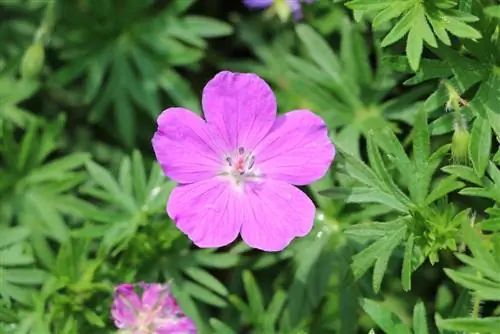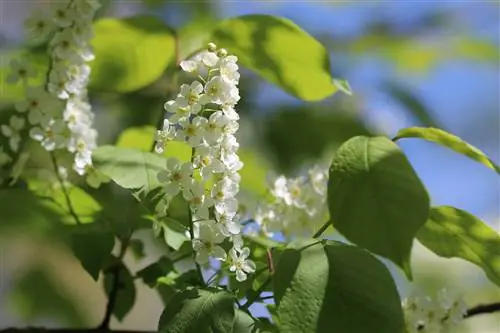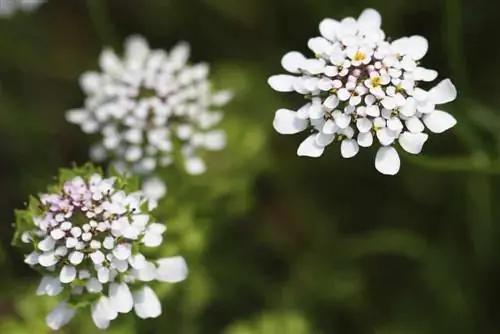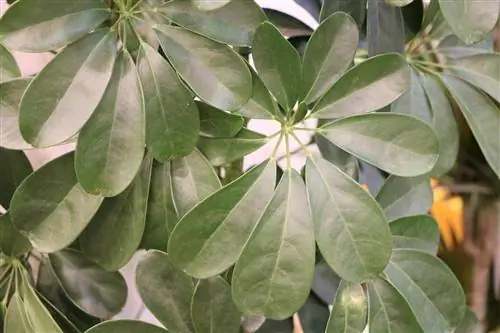- Author admin [email protected].
- Public 2023-12-17 03:39.
- Last modified 2025-01-24 12:45.
The plant genus Geranium (storksbills) includes several hundred species and an innumerable number of varieties. The plants are perennial and grow in a wide variety of locations, depending on the type and variety. The differences not only affect the location, but also the cutting and propagation of the plants. Therefore, before cutting, you should find out which species is growing in your garden.
removal cut
The so-called repair pruning in gardening terms is carried out after flowering, as it is intended to encourage the plants to bloom a second time in late summer or autumn. However, a second flowering of cranesbill is only possible with early-flowering varieties. These include those plants that bloom from around May/June. As a rule, the repair cut is carried out in July.
Note:
If it is a late-blooming cranesbill, you should not cut it in July as this will cut off the flowers that have been created.
To prune early-flowering cranesbills, proceed as follows:
- cut back dead stems and flowers to just above the ground
- Do not injure or even remove the leaf rosette when cutting
If the cranesbill seeds are intended for propagation, then you must not cut off the withered shoots. In this case, the second flower must be avoided in favor of seed formation.
pruning
Some cranesbill species tend to begin to fall apart as they get older. It is therefore advisable to cut back these stork beaks. Depending on the cranesbill species, this cut occurs in early spring or late autumn. Here is a selection of geranium species and the time of pruning, sorted by season:
In the spring you prune
- Cambridge cranesbill (Geranium x cantabrigiense)
- Heart-leaved cranesbill (Geranium ibericum)
In the fall you prune
- Blood-red cranesbill (Geranium sanguineum)
- Gnotted cranesbill (Geranium nodosum)
- Splendid cranesbill (Geranium magnificum): late autumn or winter
- Siberian cranesbill (Geranium wlassovianum): late autumn
Rejuvenation cut
Among the Geranium species, the Balkan cranesbill (Geranium macrorrhizum) and the Cambridge cranesbill (Ger.x cantabrigiense) has a special position because its stems become woody over the years. If this occurs, you can cut back the woody shoots deeply without any concerns. However, this rejuvenation cut is not necessary every year.
No cut
Among the storksbills there are also species that do not need to be cut. These include:
- Rockery cranesbills
- Geranium cinerum (Grey Cranesbill)
- Geranium dalmaticum (Dalmatian cranesbill)
- Geranium renardii (Caucasian cranesbill)
Pruning is also not necessary for all varieties in which one of the species mentioned is a parent. The reason for this is that these species are too weak-growing and would not tolerate pruning well. That's why it's enough if you cut out the withered parts of the plant.
Propagate
Storksbills are perennial and can be propagated in various ways. As with cutting, optimal propagation depends on the species.
Share
Stork beaks that are older are suitable for division. The best time for division is in March or April. However, division is also possible in summer or autumn. For the cautious variant, proceed as follows:
- Dig up plant
- Shake off the earth
- Pull apart the root ball (or divide with a spade or sharp knife)
In the less careful version, the plants are pricked apart with a spade. It is important that each shoot or several roots has.
Once the plant is divided, it can be planted immediately. Afterwards and in the next few weeks, you should water the newly acquired partial plants well so that they root quickly and well. With a bit of luck, the partial plants will bloom in the same year.
Tip: If you want to be on the safe side, you can also grow the plants in pots.

This form of propagation is suitable for the following species and almost all hybrids that have at least one of these species as a parent:
- Geranium x cantabrigiense (Cambridge cranesbill)
- Geranium clarkei (Clarke's cranesbill)
- Geranium himalayense (Himalayan cranesbill)
- Geranium macrorrhizum (Balkan cranesbill)
- Geranium magnificum (magnificent cranesbill)
- Geranium x oxonianum
- Geranium phaeum (Brown Cranesbill)
- Geranium. pratense (meadow cranesbill)
- Geranium psilostemon (Black-eyed Cranesbill)
- Geranium sylvaticum (Forest Cranesbill)
- Geranium versicolor (various-colored cranesbill)
Shoot cuttings
This method is used for cranesbills, in which all shoots come from a taproot, since these plants have no individual shoots with roots. Furthermore, shoot cuttings are recommended for plants that remain very clumpy. For this method, do the following:
- cut off young, rootless shoots with a sharp knife
- Place shoot cuttings in permeable soil
- take root after a few weeks (at high humidity)
This method is used in storksbills such as:
- “Ann Folkard”
- “Dilys”
- “Rozanne”
- “Salome” and
- Geranium wallichiarum
for use. Compared to division, propagating with shoot cuttings is more difficult and unfortunately not as successful.
Sowing
If the seeds for sowing are not purchased, then obtaining the seeds is the most difficult part of this form of propagation. Because storks' beaks throw away their seeds. Therefore, it is necessary that you do not miss the right time. Alternatively, you can cut off the entire seed heads before they are ripe and let them ripen in a paper bag.
Once the seeds have been collected, they must be stored in a cool and dark place until next spring. Once spring has come, proceed as follows: Fill sowing containers with permeable substrate
Sowing seeds
- cover with a thin layer of soil (or soil-sand mixture)
- keep slightly moist
The seeds take several weeks to germinate. Therefore, you should be patient. If seedlings are visible, they are pricked out. They only come into the garden when they have grown into stately young plants. The first flowering usually occurs in the following year.
Note:
This form of propagation is not possible with hybrids.






